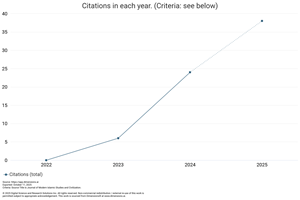Concept of Human Development Index on the Qur'an Perspective
DOI:
https://doi.org/10.59653/jmisc.v3i02.1629Keywords:
Human Development Index, Hayatan Tayyibah, Thematic Interpretation, Qur'an, Value-Based DevelopmentAbstract
This research focuses on the reinterpretation of the concept of the Human Development Index in the perspective of the Qur'an, especially through the study of Surah An-Nahl verse 97, so that the main purpose of this research is to reformulate the conceptual framework of the Human Development Index by basing the indicators of education, health, and decent living standards according to the Qur'anic values which are analyzed through qualitative methods with a library research approach and tafsir methods thematic (maudhu'i) to analyze the verses of the Qur'an that are relevant to human development. The results of the study show that the main values in HDI education, health, and welfare have normative reinforcement in the Qur'an, including in Q.S. Al-Mujādilah verse 11 (education), Q.S. Al-Baqarah verse 195 (health), and Q.S. Al-Hasyr verse 7 (distribution of welfare). These three dimensions are contained in the concept of ḥayātan ṭayyibah which is interpreted as a quality life, balanced between this world and the hereafter, and based on faith and righteous deeds. Therefore, it is necessary to integrate modern development policies with ethical and spiritual principles in Islam.
Downloads
References
‘Āsyūr, M. al-T. I. (1984). Al-Taḥrīr wa al-Tanwīr. Dār Sahnūn.
Al-Ghazālī. (2004). Iḥyā’ ‘Ulūm al-Dīn. Dār al-Kutub al-‘Ilmiyyah.
Al-Māwardī. (1996). al-Aḥkām al-Sulṭāniyyah. Dār al-Kutub al-‘Ilmiyyah.
Al-Qaradawi, Y. (2006). Fiqh al-zakah: dirasah muqaranah li-ahkamiha wa-falsafatiha fi daw al-Qur’an wa-al-sunnah. Maktabah Wahbah.
Al-Qurṭubī. (2006). Al-Jāmiʿ li Aḥkām al-Qur’ān. Dār al-Kutub al-‘Ilmiyyah.
Al-Rawi, Q. F. J. (2023). Sustainable Development in the Holy Quran and its Role in Human Construction. KnE Social Sciences. https://doi.org/10.18502/kss.v8i6.13122
Al-Razi, F. (1995). Mafātīḥ al-Ghayb. Dar Ihya’ al-Turats al-‘Arabi.
Al-Rāzī, F. al-D. (1990). Tafsīr al-Kabīr (Mafātīḥ al-Ghayb). Dār Iḥyā’ al-Turāth al-‘Arabī.
Ali, M. (2014). The Good - Wholesome Life ( Ḥayātan Ṭayyibah ) as an Islamic Lifestyle Standard. Islam and Civilisational Renewal, 5, 591–594. https://doi.org/10.12816/0009886
Almamari, B. M. M. (2022). Qur’an effect on developing positive human feelings in interest of the individual and society (Interpretation of Qur’an’s Zelal.). Journal of the Arabian Peninsula Center for Educational and Humanity Researches. https://doi.org/10.56793/pcra221395
Badan Pusat Statistik. (2023). Indeks Pembangunan Manusia 2023. Badan Pusat Statistik.
Chapra, M. U. (1992). Islam and the economic challenge (Issue 17). International Institute of Islamic Thought (IIIT).
Chapra, M. U., Khan, S., & Al Shaikh-Ali, A. (2008). The Islamic Vision of Development in the Light of Maqasid Al-Shariah (Occasional Paper). International Institute of Islamic Thought (IIIT).
Departemen Agama, R. I. (1994). al-Qur’an dan Terjemahannya: Juz 1-30. Jakarta: PT. Kumudasmoro Grafindo.
Fatah, A., & Taufiq, I. (2019). Environmental Interpretation: Hermeneutic Analysis Of The Interpretation Of Anthropocentric Verses In Al-Qur’an. Jurnal Ushuluddin, 27, 191–208. https://doi.org/10.24014/jush.v27i2.6409
Halim, I. B. A., Lateh, A. T. B. A., Ahmad, N., & Zaid, E. S. B. M. (2022). Human Development from The Perspective of Contemporary Interpretation. International Journal of Academic Research in Business and Social Sciences. https://doi.org/10.6007/ijarbss/v12-i9/15073
Hasbi, M., Munajat, M., & Qoyum, A. (2023). A Conceptual Framework of The Islamic Human Development Index (I-HDI) and its Relationship with Maqāṣid Al-Sharī’ah. Amwaluna: Jurnal Ekonomi Dan Keuangan Syariah. https://doi.org/10.29313/amwaluna.v7i2.10910
Hocini, M. A., Abdullah, M., & Bounama, F. (2020). The Qur’anic Aspects of Human Development With Special Reference to the Role of ‘Aqīdah in Tafsīr al-Zilāl of Sayyid Quṭb: A Thematic Study. Jurnal Akidah & Pemikiran Islam. https://doi.org/10.22452/AFKAR.VOL22NO2.10
Jannah, N., Tarigan, A. A., Helmi, M., & Harahap, F. A. (2022). Rethinking Human Development: Contributions of Mahbub Ul Haq, Amartya Sen, and Umer Chapra to Conventional and Islamic Indices. Economica: Jurnal Ekonomi Islam. https://doi.org/10.21580/economica.2022.13.2.13576
Kathīr, I. (1999). Ismāʻīl, Tafsīr al-Qurʼān al-ʻAẓīm. Dār Ṭaybah Lil-Nashr & Al-Tawzīʻ, Al-Qāhirah.
Krippendorff, K. (2018). Content analysis: An introduction to its methodology. Sage publications.
Max-Neef, M. A., Elizalde, A., & Hopenhayn, M. (1991). Human scale development: conception, application and further reflections. (No Title).
Purbaningsih, R. Y. P. (2021). The Effect Of Poverty And Economic Growth On Human Development Index (Hdi) In Islamic Economic Perspective In Jambi Province 2014-2019. https://consensus.app/papers/the-effect-of-poverty-and-economic-growth-on-human-purbaningsih/07896d519abd5e3ea55c3d62520c9f61/
Qutb, S. (2000). Fī Ẓilāl al-Qur’ān. Dār al-Shurūq.
Sen, A. (1999). Development as Freedom Oxford University Press Oxford. trang.
Shihab, M. Q. (2002). Tafsir al-misbah. Jakarta: Lentera Hati, 2, 52–54.
Stiglitz, J. E. (2012). The price of inequality: How today’s divided society endangers our future. WW Norton & Company.
Sumarto, M. (2021). Pembangunan dan Ketimpangan di Indonesia: Analisis Sosial Ekonomi. LP3ES.
Ṭabarī. (2000). Jāmiʿ al-Bayān ʿan Ta’wīl Āy al-Qur’ān. Dār al-Fikr.
Tambunan, K., Harahap, I., & Tarigan, A. A. (2022). Human Development Index (Hdi) In The Qur’an From The Quraish Shihab’s Perspective. Human Falah: Jurnal Studi Ekonomi Dan Bisnis Islam. https://doi.org/10.30829/hf.v9i2.13367
UNDP, U. (1994). Human development report 1994: New dimensions of human security. New York. Retrieved December, 12, 2022.
United Nations Development Programme. (2023). Human Development Report 2023. UNDP.
Yahaya, N., & Hanapi, M. (2020). Humankind as Actors of Development According to the Al-Qur’an. The International Journal of Academic Research in Business and Social Sciences, 10. https://doi.org/10.6007/ijarbss/v10-i4/7161
Downloads
Published
How to Cite
Issue
Section
License
Copyright (c) 2025 Dedi Mardianto

This work is licensed under a Creative Commons Attribution-ShareAlike 4.0 International License.
Authors who publish with this journal agree to the following terms:
- Authors retain copyright and grant the journal right of first publication with the work simultaneously licensed under a Creative Commons Attribution-ShareAlike that allows others to share the work with an acknowledgement of the work's authorship and initial publication in this journal.
- Authors are able to enter into separate, additional contractual arrangements for the non-exclusive distribution of the journal's published version of the work (e.g., post it to an institutional repository or publish it in a book), with an acknowledgement of its initial publication in this journal.
- Authors are permitted and encouraged to post their work online (e.g., in institutional repositories or on their website) prior to and during the submission process, as it can lead to productive exchanges, as well as earlier and greater citation of published work (See The Effect of Open Access).
























